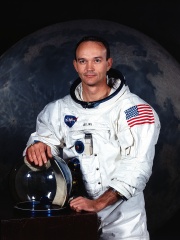
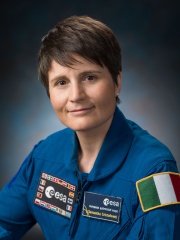

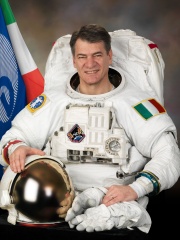
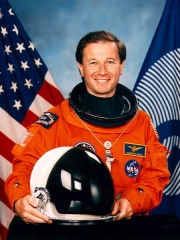
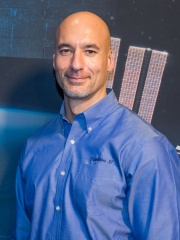
The Most Famous
ASTRONAUTS from Italy
This page contains a list of the greatest Italian Astronauts. The pantheon dataset contains 556 Astronauts, 7 of which were born in Italy. This makes Italy the birth place of the 8th most number of Astronauts behind Japan, and Canada.
Top 7
The following people are considered by Pantheon to be the most legendary Italian Astronauts of all time. This list of famous Italian Astronauts is sorted by HPI (Historical Popularity Index), a metric that aggregates information on a biography's online popularity.

1. Michael Collins (1930 - 2021)
With an HPI of 81.19, Michael Collins is the most famous Italian Astronaut. His biography has been translated into 80 different languages on wikipedia.
Michael Collins (October 31, 1930 – April 28, 2021) was an American astronaut who flew the Apollo 11 command module Columbia around the Moon in 1969 while his crewmates, Neil Armstrong and Buzz Aldrin, made the first crewed landing on the surface. He was also a test pilot and major general in the U.S. Air Force Reserve. Born in Rome, where his father was serving as the U.S. military attaché, Collins graduated in the Class of 1952 from the United States Military Academy. He followed his father, brother, uncle, and cousin into the military. He joined the United States Air Force, and flew F-86 Sabre fighters at Chambley-Bussières Air Base, France. He was accepted into the U.S. Air Force Experimental Flight Test Pilot School at Edwards Air Force Base in 1960, also graduating from the Aerospace Research Pilot School (Class III). Selected as part of NASA's third group of 14 astronauts in 1963, Collins flew in space twice. His first spaceflight was on Gemini 10 in 1966, in which he and Command Pilot John Young performed orbital rendezvous with two spacecraft and undertook two extravehicular activities (EVAs, also known as spacewalks). On the 1969 Apollo 11 mission, he became one of 24 people to fly to the Moon, which he orbited thirty times. He was the fourth person (and third American) to perform a spacewalk, the first person to have performed more than one spacewalk, and, after Young, who flew the command module on Apollo 10, the second person to orbit the Moon alone. After retiring from NASA in 1970, Collins took a job in the Department of State as Assistant Secretary of State for Public Affairs. A year later, he became the director of the National Air and Space Museum, and held this position until 1978, when he stepped down to become undersecretary of the Smithsonian Institution. In 1980, he took a job as vice president of LTV Aerospace. He resigned in 1985 to start his own consulting firm. Along with his Apollo 11 crewmates, Collins was awarded the Presidential Medal of Freedom in 1969 and the Congressional Gold Medal in 2011.

2. Samantha Cristoforetti (b. 1977)
With an HPI of 54.29, Samantha Cristoforetti is the 2nd most famous Italian Astronaut. Her biography has been translated into 47 different languages.
Samantha Cristoforetti (Italian pronunciation: [saˈmanta kristofoˈretti]; born 26 April 1977) is an Italian European Space Agency (ESA) astronaut, former Italian Air Force pilot and engineer. She is the second of two women sent into space by ESA and the first from Italy. Cristoforetti holds the record for the longest uninterrupted spaceflight by a European astronaut (199 days, 16 hours), and she held the record for the longest single space flight by a woman until this was broken by Peggy Whitson in June 2017, and later by Christina Koch. She took command of ISS Expedition 68 on 28 September 2022. In December 2021, Politico Europe named her as one of the "dreamers" in its annual list of the 28 most influential people in Europe.

3. Roberto Vittori (b. 1964)
With an HPI of 52.38, Roberto Vittori is the 3rd most famous Italian Astronaut. His biography has been translated into 29 different languages.
Brigadier Roberto Vittori, OMRI (born 15 October 1964, in Viterbo) is an Italian Air Force officer and an ESA astronaut. After graduating from the Italian Accademia Aeronautica in 1989, Vittori flew in the Italian Air Force. He then trained as a test pilot in the United States. In 1998, Vittori was selected by the ESA to join the European Astronaut Corps. Since then, he has participated in three spaceflights: the Soyuz TM-34/33 and Soyuz TMA-6/5 taxi flights to the ISS, as well as STS-134, the penultimate mission of the American Space Shuttle Program in 2011. He was the last non-American to fly aboard the Shuttle.

4. Paolo Nespoli (b. 1957)
With an HPI of 52.34, Paolo Nespoli is the 4th most famous Italian Astronaut. His biography has been translated into 32 different languages.
Major Paolo Angelo Nespoli (born 6 April 1957) is an Italian astronaut and engineer of the European Space Agency (ESA). In 2007, he first traveled into space aboard the Space Shuttle Discovery as a mission specialist of STS-120. In December 2010 he again traveled into space aboard the Soyuz TMA-20 spacecraft as an Expedition 26/27 flight engineer. Nespoli's third spaceflight was on board Soyuz MS-05, which launched in July 2017 for Expedition 52/53. He was also the European Space Agency's oldest active astronaut prior to his retirement in 2019.
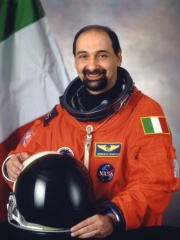
5. Umberto Guidoni (b. 1954)
With an HPI of 50.85, Umberto Guidoni is the 5th most famous Italian Astronaut. His biography has been translated into 21 different languages.
Umberto Guidoni (born 18 August 1954 in Rome) is an Italian astrophysicist, science writer and a former ESA astronaut, being the first European to visit the International Space Station. He is a veteran of two NASA Space Shuttle missions. He was also a Member of the European Parliament (MEP) from 2004 to 2009, with the Group of the European United Left (GUE/NGL).

6. Maurizio Cheli (b. 1959)
With an HPI of 48.97, Maurizio Cheli is the 6th most famous Italian Astronaut. Her biography has been translated into 20 different languages.
Maurizio Cheli (born 4 May 1959) is an Italian air force officer, a European Space Agency astronaut and a veteran of one NASA Space Shuttle mission.

7. Luca Parmitano (b. 1976)
With an HPI of 48.38, Luca Parmitano is the 7th most famous Italian Astronaut. His biography has been translated into 24 different languages.
Luca Parmitano (born 27 September 1976 in Paternò, Sicily) is an Italian astronaut in the European Astronaut Corps for the European Space Agency (ESA). He was selected as an ESA astronaut in May 2009. Parmitano is also a colonel and test pilot for the Italian Air Force. He is the first Italian (and the third European) to command the International Space Station (ISS) during Expedition 61.
People
Pantheon has 7 people classified as Italian astronauts born between 1930 and 1977. Of these 7, 6 (85.71%) of them are still alive today. The most famous living Italian astronauts include Samantha Cristoforetti, Roberto Vittori, and Paolo Nespoli. The most famous deceased Italian astronauts include Michael Collins.
Living Italian Astronauts
Go to all RankingsSamantha Cristoforetti
1977 - Present
HPI: 54.29
Roberto Vittori
1964 - Present
HPI: 52.38
Paolo Nespoli
1957 - Present
HPI: 52.34
Umberto Guidoni
1954 - Present
HPI: 50.85
Maurizio Cheli
1959 - Present
HPI: 48.97
Luca Parmitano
1976 - Present
HPI: 48.38

